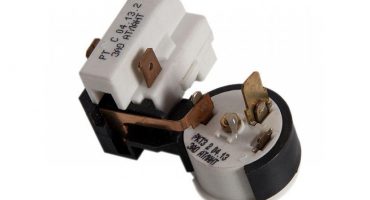- What does a “linear compressor” mean for a household refrigerator and what is the principle of its operation?
- How is the compressor from the domestic refrigerator arranged and how is it used?
- Technical characteristics of linear compressors used in refrigeration units
- Advantages and disadvantages
- To summarize
Speaking in a language that is understandable to a simple consumer, the “heart” of a refrigerator is a compressor. It is this device that sets in motion the "blood" of any of the refrigerators - a refrigerant that cools, or rather, removes heat from the refrigerator and freezer. The noise made by the refrigerator is nothing but the sound made by the compressor.
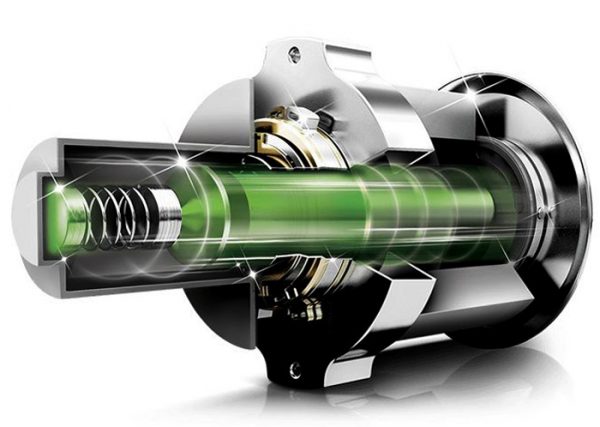
Domestic refrigerator linear compressor
Trying to please the consumer, manufacturers are constantly in search of solutions that would reduce energy consumption, noise and the cost of household refrigerators. Thanks to new technologies, today there is a fairly simple and energy-efficient design, called the “linear compressor”.
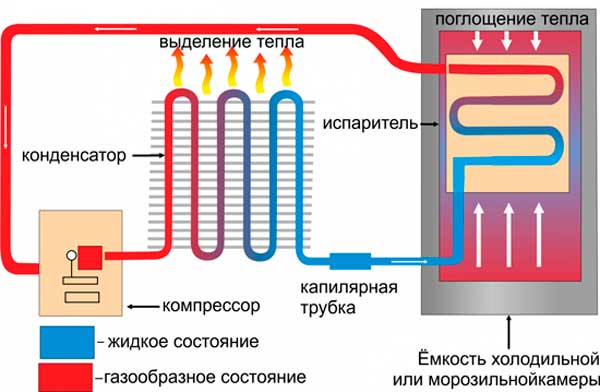
The principle of operation of the refrigerator
What does a “linear compressor” mean for a household refrigerator and what is the principle of its operation?
To date, the refrigeration industry uses three main type of compressor refrigerators: piston with a crank mechanism, linear and inverter.
The first such devices were created and installed in their refrigerators by LG. But the technology turned out to be so successful that over time other famous manufacturers of refrigerators began to use this type of compression machines. Today, in the vast majority of refrigerators, one or more linear as well as inverter compressors are installed.
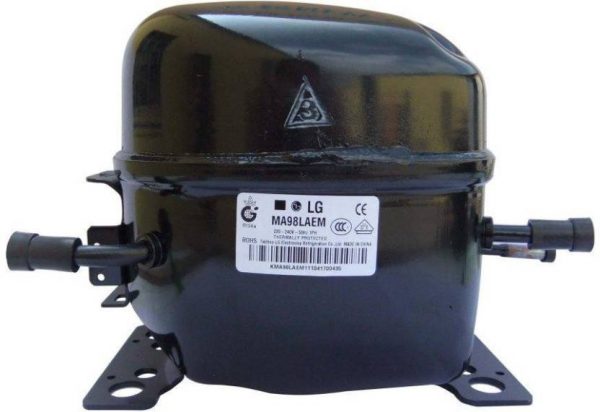
Linear compressor assembly
Unlike earlier designs, when piston compressors with a crank mechanism driven by an electric motor were used, modern linear units got rid of the electric motor and crankshaft, and at the same time the number of friction points decreased, which made them noticeably quieter (by 15- 20 dB), and the efficiency is higher. The role of the drive device received a solenoid, the core of which is connected to the piston. When flowing through an AC coil, the rod moves the piston in a certain direction, thereby compressing the refrigerant. Then the spring located at the end of the rod returns it to its original position and the process repeats. Thus, the reciprocating motion of the piston creates pressure in the cooling line.
The operation scheme of the linear unit is organized according to the principle of a hysteresis loop, i.e. maintaining the set temperature in the refrigerator is ensured by turning the system on / off when certain temperatures are reached, which are constantly monitored by temperature sensors. For example, at a given temperature of + 5⁰C, the device turns on when the temperature sensor informs it of a temperature of + 7⁰C in the chamber, and turns off when the temperature reaches + 3⁰C.
However, the operation of the inverter linear machine is slightly different. It is called inverter because of currents of different frequencies that form an AC inverter. Due to the change in these currents, the amplitude of the piston stroke also changes, as a result of which the pressure decreases, that is, the “inverter” does not turn on and off as usual, but works permanently, but changes its performance. It is this fact that makes this technology much quieter than older versions.
How is the compressor from the domestic refrigerator arranged and how is it used?
The main components of the design:
- Cylinder;
- Winding electromagnetic coil;
- The piston rod;
- Compensation spring;
- Rod spring.
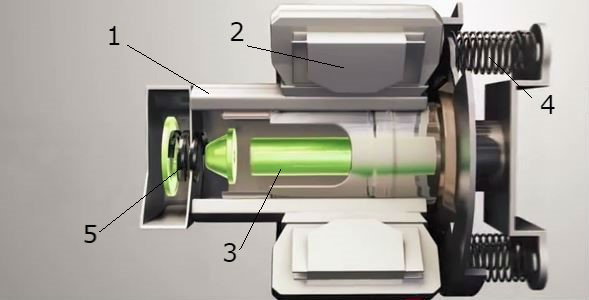
The device of the linear compressor from the refrigerator
The design also contains numerous gaskets, seals and valves, which serve for the normal operation of the system.
A cylinder is a housing in which a core moves, which is a piston rod. It is made, like the core, mainly from stainless steel. The coil of the solenoid is copper, serves to induce the EMF and set the core in motion. The spring of the rod takes it to its original position, while the compensation springs dampen the vibration from the back and forth movements of the core (rod). The material of the springs is steel.
The voltage is supplied through the inverter, it is forbidden to directly connect the device to the network, as this can lead to damage. The inverter, in turn, is controlled by a signal (5 VDC) from the electronic board. Also, a starting capacitor is required for starting.
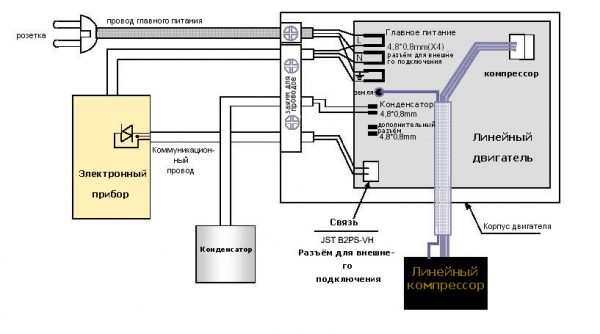
Connection diagram
Technical characteristics of linear compressors used in refrigeration units
The main technical indicators of the compressors are working pressure, cooling capacity and electric power.
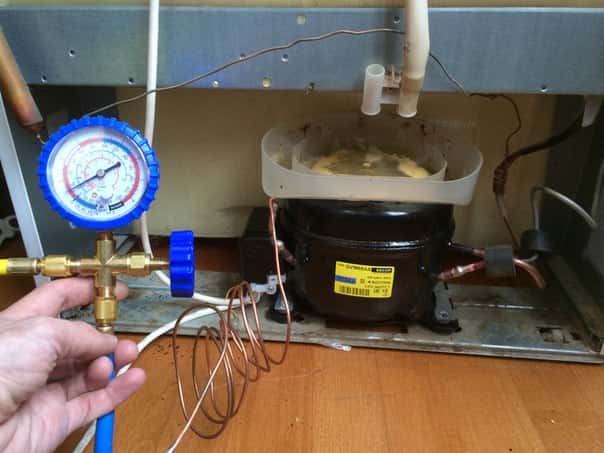
Compressor Pressure Check
The working pressure pumped by a standard refrigerator compressor ranges from 2 to 4 atmospheres. It is this pressure level that is necessary for the circulation of freon in a closed system. Regulators keep the pressure in the system at this level so that the refrigerant pipes do not burst. Disconnected from the system, it is capable of delivering up to 15 atmospheres. The longer the unit runs, the higher the pressure is created.
The refrigerating capacity is directly proportional to the electric power, measured in kcal / hour (at a temperature of -23⁰С, and also depends on the compressor model and brand of refrigerant. The following is an example of the performance table of LG models operating on R12 brand freon:
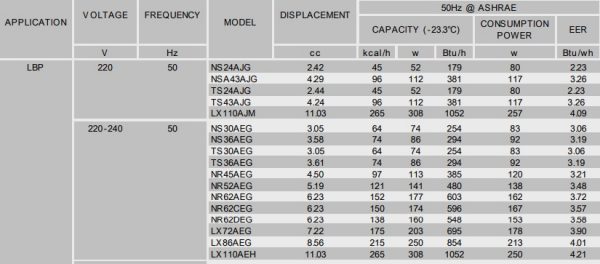
LG linear compressor performance chart
Based on the table, for example, the NS24AJG model has a power consumption of 80 W and a cooling capacity of 45 kcal / hour.
Often, to diagnose a compressor malfunction, the resistance value of the coil windings is measured. To do this, connect a multimeter between the device body and the winding. If the resistance is much higher than normal - there is a gap in the windings, if the resistance is less - a short circuit may have occurred. The resistance value for each model is different. For example, for the FA88NAET model, the normal resistance lies between 14 and 15.5 Ohms, and for the FA102NBET, it is between 9 and 10 Ohms.
Advantages and disadvantages
Like everything in our world, linear compressors have their pros and cons.
The benefits include:
- This type is by far the most common. In the first models, the compressor turned on quite loudly, but technology is moving forward, and modern refrigerators of the best world manufacturers now work almost silently.
- Another advantage is a high level of ecology. Today, these units are considered the least energy-consuming, and environmental services claim that the refrigerant used does not pose a danger to the environment and does not harm our planet.
- The next plus is the insensitivity of linear compressors to voltage surges, which puts them one notch higher than “inverters”, which usually protect against surges in the network with a voltage stabilizer, which, accordingly, affects the price upwards.
- And the final plus can be called one of the most important factors for buyers - its market price. Despite the more technically advanced “inverters”, refrigerators with a linear compressor are popular just because of the price / quality ratio, which, in turn, encourages manufacturers to introduce more and more new models of refrigerators with a linear type of compressor, as well as search ways to reduce the cost of "inverters".
Of the disadvantages:
- Uneven product cooling. Since the compressor operates in peak load cycles, the temperature fluctuates accordingly, albeit slightly.Most likely, each owner of a device of this type paid attention to the blinking of the light bulb when the refrigerator was turned on, this indicates the effect of peak currents on the wiring in the house.
- Often owners of refrigerators with a linear compressor complain of increased noise levels. Yes, this is another drawback, however, increased noise is characteristic mainly of cheaper versions. Therefore, it is still worth asking the store to turn on the refrigerator, as, perhaps, a more expensive and quieter model will be more suitable for noise.
- The last drawback is the unreliability and fragility, in comparison with inverter models, again due to the cyclic operation and frequent starting load, which is not inherent in “inverters”. So those who want to save on the purchase of a refrigerator and stop on the option with a linear compressor, in the future they will have to put up with high operating costs. And, on the contrary, an expensive refrigerator with an “inverter” will reduce costs during its further use.
To summarize
We can say that today in the market of refrigeration units, with energy class A ++ and higher, two types of cooling systems prevail: with a linear and an inverter compressor. Linear ones have proved themselves to be energy-efficient, environmentally friendly and relatively inexpensive, while refrigerators with an inverter compressor will have to pay a larger amount, but save in the future due to reliability and durability.

Line compressor in domestic refrigerator
Among manufacturers of refrigerators with a linear compressor, the LG brand dominates the market, which is not surprising, since it was this company that first applied this system in its models. However, drawing attention to the obvious success of such refrigerators among consumers, linear compressors are widely used in the world among leading manufacturers of refrigeration equipment.
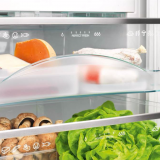 Pros and Cons of Nou Frost Refrigerators
Pros and Cons of Nou Frost Refrigerators 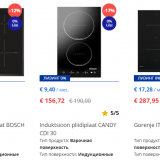 Refrigerator next to the stove and oven - can I?
Refrigerator next to the stove and oven - can I?  Is it possible to hang fridge magnets
Is it possible to hang fridge magnets  How to choose a good two-chamber refrigerator and features of its device
How to choose a good two-chamber refrigerator and features of its device  The water in the refrigerator does not go away and why the water does not freeze in the freezer - what to do
The water in the refrigerator does not go away and why the water does not freeze in the freezer - what to do 